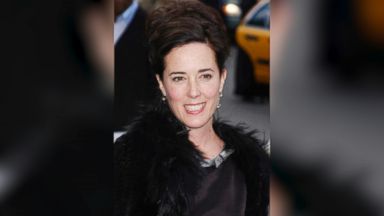How Kate Spade's tragic death is shedding light on depression, suicide
Coming up in the next {{countdown}} {{countdownlbl}}
Coming up next:
{{nextVideo.title}}
{{nextVideo.description}}
Comments
Related Extras
Video Transcript
Transcript for How Kate Spade's tragic death is shedding light on depression, suicide
We'll begin with our "Gma" cover story as we learn more about Anthony bourdain's death, Kate spade's father is speaking out about their family's tragic loss and new numbers out from the CDC show a dramatic increase in the number of Americans dying by suicide. ABC's Deborah Roberts is here with more on this growing mental health crisis, Deborah, good morning. Reporter: Good morning, Paula. So many reeling from another shocking death, this time as you say CNN's Anthony bourdain reportedly a suicide on the heels of the death of Kate spade. Well, for so long there has been caution around public discussion of suicide. Some medical experts believe it can lead to a contagion the tragic growing problem getting even worse but today Kate spade's father as you say is speaking out trying to help those who are vulnerable. As they grapple with the despair the why and how, Kate spade's family seems determined to make her sudden and inexplicable death a teachable moments for others hurting. Spade's father in his grief telling "The Kansas City star" one thing we feel any talk they do that helps somebody else Katy would have liked that. If that helped anybody avoid anything, fine, she'd be delighted. Her husband of 24 years Andrew confirming his wife was battling depression and anxiety for years but fashion observers realize she wasn't alone. In 2014 designer Loren Scott took her life. She was battling depression too. Experts saying it is time for a serious discussion about mental illness and the toll it takes particularly on women. Depression has been called the invisible disease because there's not an x-ray we can do. There is not a blood test we can do so it is so prevalent and yet still so underrecognized. Reporter: Suicide rates among women due to emotional distress is on the rise. According to a brand-new report from the CDC released just Thursday women with mental health issues such as depression or anxiety were nearly twice as likely to resort to taking their own lives. And though the report cites many factors, relationship problems ranked most often at 42%. Feelings of isolation, abandonment and guilt are big drivers of suicide. And that's why it's so important to diagnose it early and to treat it. Reporter: An urgent conversation moving out of the shadows this morning, CDC experts cautioning that suicide isn't strictly a mental health issue since half of those who take their lives hadn't been diagnosed. So the big warning, if you know someone who has recently had a big or traumatic change in their life or appears to be feeling isolated begin a conversation, help them find support as the spade family suggests let her tragedy help save lives. Paula. Thank you. Dr. Jennifer Hartstein joins us right now. We saw the numbers from the CDC. This is a crisis. They're calling their own data disturbing but we know the rates have climbed dramatically, more suicides in 2016 than car accidents and homicides and now in light of Kate spade we know it disproportionately affects middle-aged women but now with the news of Anthony bourdain it affects everyone. Men has three times as many completed suicides. Men tend to complete more mostly because of the lethality of their means. It's like one every ten minutes so in the United States it's the tenth leading cause of death. More than homicide. It is a crisis, something I'm so glad we're able to talk about in light of these tragedies because we need to address the stigma and open the conversation so people don't feel the shame about it and can ask for help. We need to be mindful of how we are covering suicides. We saw after robin Williams' suicide rates went up 10%. We know Kate spade reportedly was infatuated with his suicide as well. How can we be mindful as members of the media in how we are covering suicide because there's something known as suicide contagion. It is something we have to worry about and historically we've looked at this with young people, with teens and the neighborhood. If it happens in a school how it affects the other teenagers. We have to think about what language are we using? Are we glamorizing the idea that their lives were so challenging that this was their only way out or sharing information that doesn't need to be shared case in point, the discussion of what Kate might have said to her daughter. That's not information we all need to be sharing and I think in the media we need to share how do you access help? What are the resources for tem because you have a platform to do that. Quick we know there aren't always warning designs but what are the clear-cut warning signs. Increase in depression, just in depression and sadness, change in behavior, maybe there is some giving away of personal belongings saying good-bye or just flat out talk about death. Fake all of that seriously and don't be afraid to ask if they're thinking about suicide. You are not giving them the idea if it's already there. Thanks for having a tough conversation. If you or someone you know needs help we encourage you foe please call the suicide prevention lifeline on the bottom of our screen.
This transcript has been automatically generated and may not be 100% accurate.



















